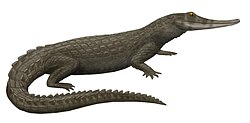Isisfordia
|
Isisfordia Temporal range: Early-Late Cretaceous, Albian–Cenomanian |
|
|---|---|
 |
|
| Scientific classification | |
| Kingdom: | Animalia |
| Phylum: | Chordata |
| Class: | Reptilia |
| Clade: | Eusuchia |
| Genus: |
†Isisfordia Salisbury et al., 2006 |
| Type species | |
|
†Isisfordia duncani Salisbury et al., 2006 |
|
Isisfordia (named after the discoverer; former Deputy Mayor of Isisford, Ian Duncan) (holotype QM F36211) is an extinct genus of crocodyliform closely related to crocodilians that lived during the Middle Cretaceous (Albian–Cenomanian). Its fossils were discovered in the Winton Formation in Isisford, Queensland, Australia in the mid-1990s. Most of the animal was discovered, with the exception of the front portion of the skull. On a later expedition to the location, paleontologists discovered a complete skull which differed from the original specimen in size only.
The estimate of the length of Isisfordia is about 1.1 m (3.6 feet).
The discovery of the fossilized remains led paleontologists to suggest that the group including modern crocodilians first evolved 30 million years earlier than previously thought, during the Cretaceous period on the supercontinent Gondwana. Analysis of the remains concluded that the vertebrae fit together as they do in modern crocodilians, via loose ball-and-socket joints, as well as a secondary palate similar to that in living crocodilians which allows them to let air pass into the lungs without entering the inside of the mouth.
...
Wikipedia
